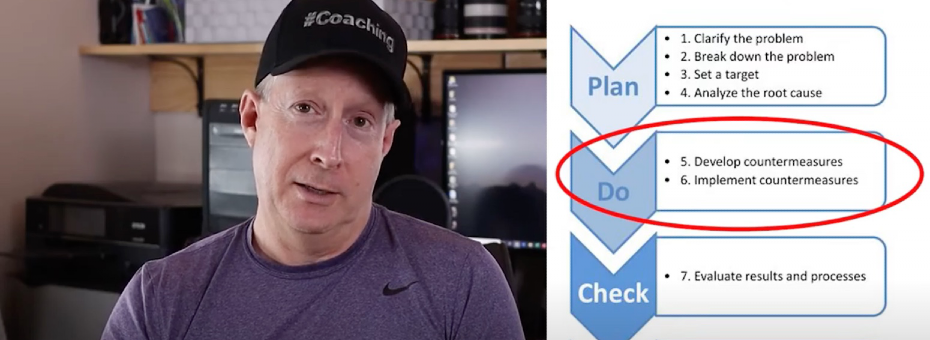Part 1 of 2. Be sure to tune in next Friday, for part 2, in which Art further explains the A.D.P. methodology by exploring how it applies to the countermeasures you can take to protect yourself and staff from Covid-19.
Hi, everyone. This is Art Smalley, president of Art of Lean Incorporated. I hope you’re all staying safe and doing well. Today on behalf of the Lean Enterprise Institute, I’m going to share a problem-solving coaching tip that I developed and like to use with my clients. I hope that you’ll be able to take it and adapt it to your respective situations. Today, I’ll share with you the basic concept behind it, and then in a follow-up video, I’ll give you a couple of practical applications, and then I’ll give you a homework assignment for you to try it on your own. I think you’ll enjoy it.
Now, everyone generally has their favorite style of problem-solving. It usually depends upon what they learn first and how they like to think. It could be something like design thinking; it could be the Russian model of TRIZ, which stands for theory of inventive problem-solving. It could be more statistical in nature, like 6 Sigma and DMAIC routines, or something more basic and logical like 8D or the Toyota Business Practice and its steps for problem-solving. Or it could be something more action-oriented like Kaizen or a Just Do It flavor style of things.
Regardless, all of these tend to have a step in them, at some point in the process where you say we’re going to implement action items to solve the problem. And collectively, we call these corrective action items or countermeasures or some term like that. It depends upon the industry and where you work. Everybody has their favorite little flavor, service, healthcare, manufacturing, sports, military, and — yeah, military is a little different.
Regardless, in most cases, though, we talk about corrective action items or countermeasures.
Okay. Let’s assume that regardless of whatever style of problem-solving methodology that you’re following, you get to a root cause insight. And of course, that’s no trivial matter. That’s usually half the battle, if not more. Regardless, even if you come up with a root cause insight, you then need to go to the next level and think through, what do we do about it? How do we solve the problem? And this is where corrective actions and countermeasures come into play. And unlike the military and the airplane example, we don’t get to launch things out the back end and just have it blow up and go away. That’d be nice sometimes. We could do that in industry, but usually, we can’t do that.
Here’s when I want you to think of the acronym A, D, and P. That’s today’s tip, A.D.P. “A” stands for administration, “D” stands for detection, and “P” stands for prevention. And whenever you’re brainstorming countermeasures or coaching somebody on the thought process of developing theirs, I want you to invoke this technique and think through each type and category, because they have respective strengths and weaknesses associated with them. By default, humans tend to default towards the administrative side right away and not think more deeply about the detection and the prevention routines that I want to get at.
Join the non-profit Lean Enterprise Institute at the Virtual Lean Learning Experience, or VLX, a 10-week Master Class starting September 14 featuring:
- presenters from the foremost lean practitioners
- advice and informal coaching from LEI Coaches
- challenging hands-on activities that ensure deep, practical takeaways
- opportunities to make lifelong connections with lean colleagues
Learn more and register at https://www.lean.org/summit2020
Let’s start with the “A” category for administration. By administration, I refer to measures that tend to address the human or documentation side of the process that you’re dealing with. For example, things involving job instruction or worker training, standardized work, inspection, audits, containment, visual aids, alerts, anything like that that gets posted as a way to affect the individual or remind people to do something, I refer to that as administration or managing the process. In reality, these are sometimes necessary for the short term — things you can immediately do, but rarely if ever do they get at the underlying conditions and preventing the real root cause. In their defense, sometimes it’s something you do early and quick as a way of mitigating the problem, but rarely do they work in the long run addressing the real root cause of the problem.
Now, a step up from the “A” category of corrective actions or countermeasures is the “D,” which stands for detection. And of course, detection is superior to administration because it doesn’t rely upon the human aspect. It goes farther and looks at the process and says, what can I do in the process with gauges, sensors, devices, techniques that automatically detect the problem situation, if and when it occurs, and stop it from getting out of the process and going downstream or to the customer or anything like that?
It’s superior to administration because it’s not human dependent. You’re taking the human out of the equation and say interlocking it or saying that I will catch the problem when it occurs and stop it in process. In Toyota, we use the Japanese phrase jidoka for this, and there are many associated terms, such as mistake-proofing, error-proofing, et cetera. So “D” is fundamentally a stronger and more robust type of countermeasure than administration.
Now the third category of countermeasures or corrective actions is the “P” or preventive style. And this is, of course, what you want to strive for in the long run. Prevention is best because it doesn’t just administer the process through training or some other mechanism. It doesn’t just detect the problem, but you’re going after the real root cause and the underlying conditions and factors which allowed it to happen in the first place.
And of course, this is always easier said than done. In Toyota, we had two different categories of prevention. We called one …, which is recurrence prevention. And the other is …, which is pre-occurrence prevention where you’d stop it before it happened. We’ll save that for another video in the future. However, the point is on both, they’re preventive, and they fundamentally stop an error in its tracks and doesn’t allow the problem to happen again. And this is what you want to strive for in any problem-solving endeavor.
Okay. In summary, I want you to remember the acronym, A.D.P., for administration, detection, and prevention. Whenever you’re dealing with countermeasures or corrective action items, regardless of whether you’re solving a problem yourself or coaching someone else, think of this fram






